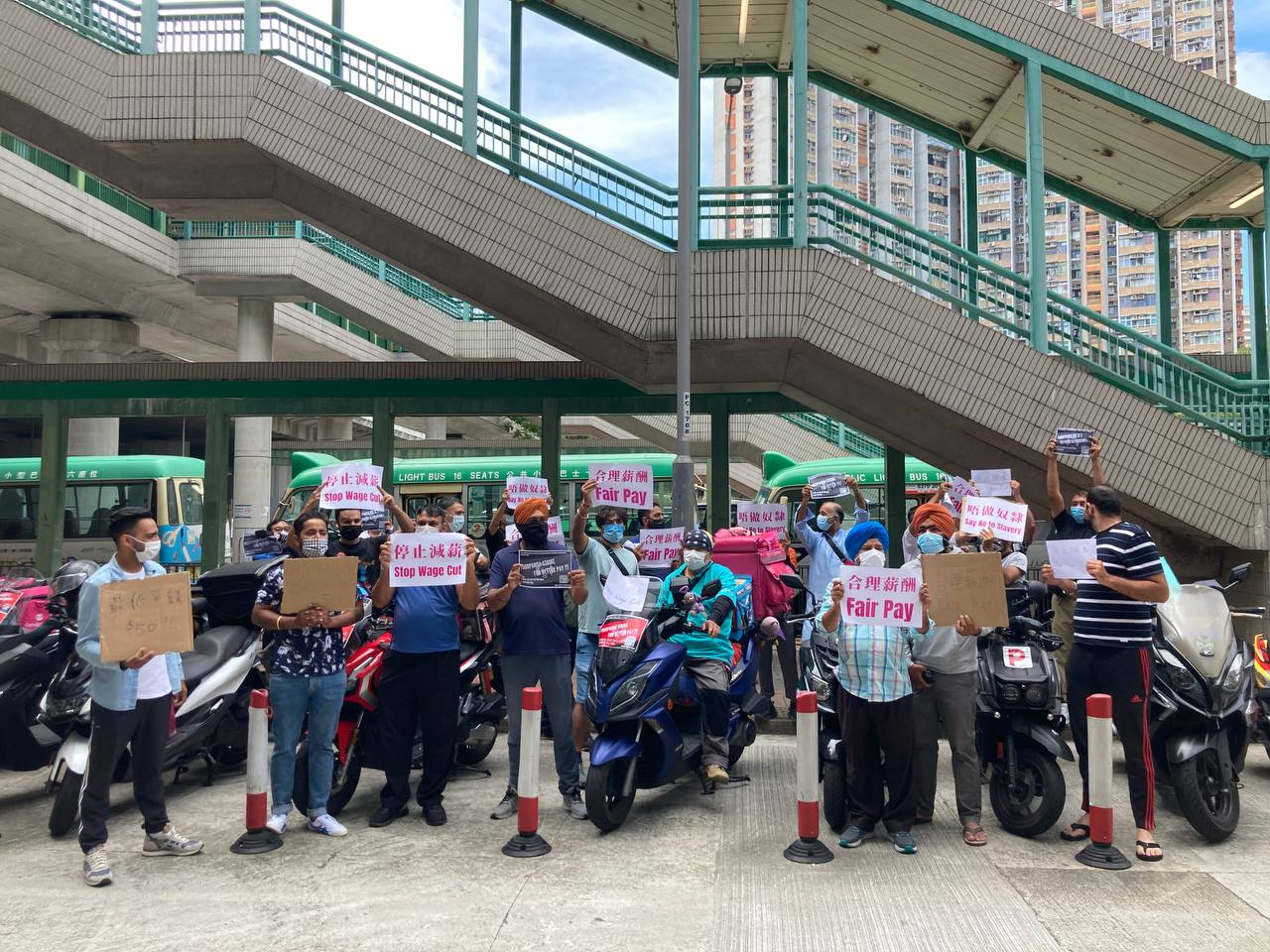
Dispatch: The Rise And Fall Of Hong Kong’s Courier Strike
Over the past two years, unofficial strikes by delivery workers have taken Hong Kong’s establishment by surprise. During a recent trip back home, voice.wales reporter Ka Long Tung spoke to activists involved in the strikes about their experience of mobilising workers and the challenges they face.
By Ka Long Tung. Cover image: Striking workers gather. All images via the Concern group.
In Hong Kong, dozens of South Asian delivery workers gathered to demand better pay from the boss they had never seen.
It was October 2021, and the workers were protesting during a two-day strike over pay and working conditions.
The scale of the action took the company, foodpanda, by surprise, given the absence of any union organisation within the workforce.
Two and a half years later, activists in the notoriously hard-to-organise industry are still fighting, in a battle that has lessons for courier workers everywhere.
Pay cut while business grows
The arrival of the Covid19 pandemic paved the way for the huge growth of delivery platforms, with both increased concern for personal safety and tight restrictions.
With the last Covid restrictions for restaurants in Hong Kong still in place up to October 2022, the market for food delivery stayed strong.
But this increase in business did not stop foodpanda, which is owned by Berlin-based ‘Delivery Hero’, cutting workers’ pay by as much as 30 per cent.
This triggered delivery workers to organise themselves in different regions using whatever networks they had.
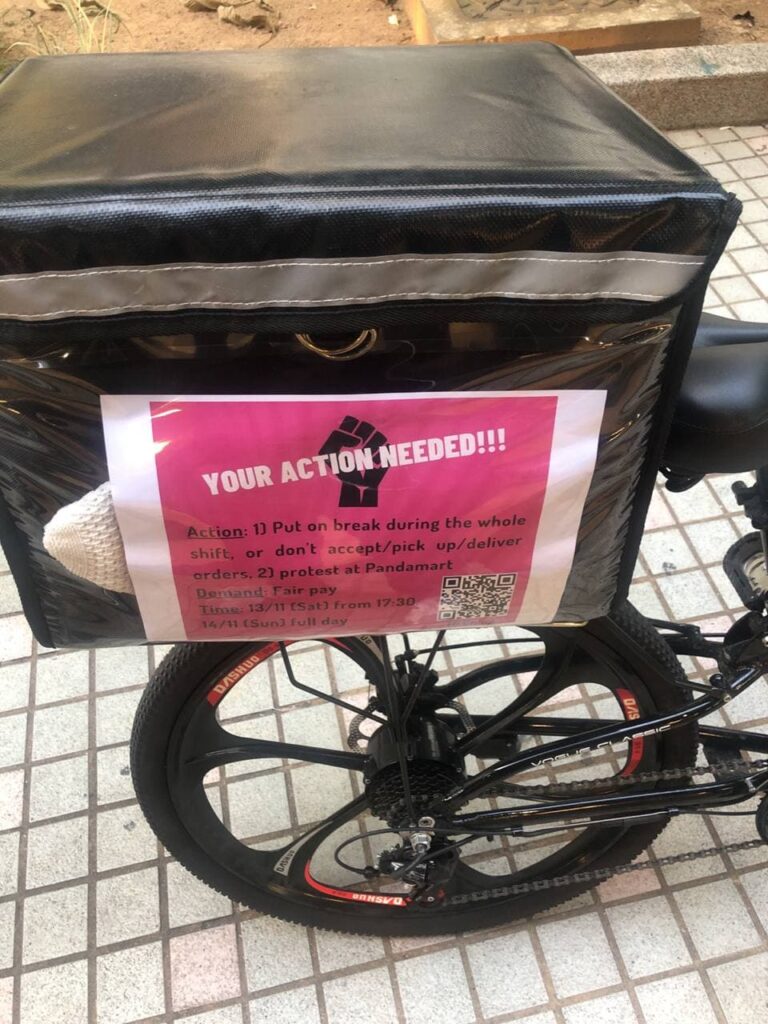
It was a difficult time for trade unions in Hong Kong, with the Confederation of the Trade Unions (HKCTU), recently disbanded because its pro-democracy stance put it in danger under a crackdown by the authorities.
But the strike took off nonetheless and without an official union behind it.
The scale of the action took many by surprise, as strikes are generally rare in Hong Kong and it was the first of its kind for delivery workers.
Workers spread the information of the strike in any way they could, even sticking posters to their bikes and motorbikes to encourage others to join the movement.
The key tactic of the strike was to leave food orders that were ready for collection waiting, resulting in lost business and chaos for the company. Some Pandamarts, a foodpanda-owned supermarket. were even shut during the two-day strike.
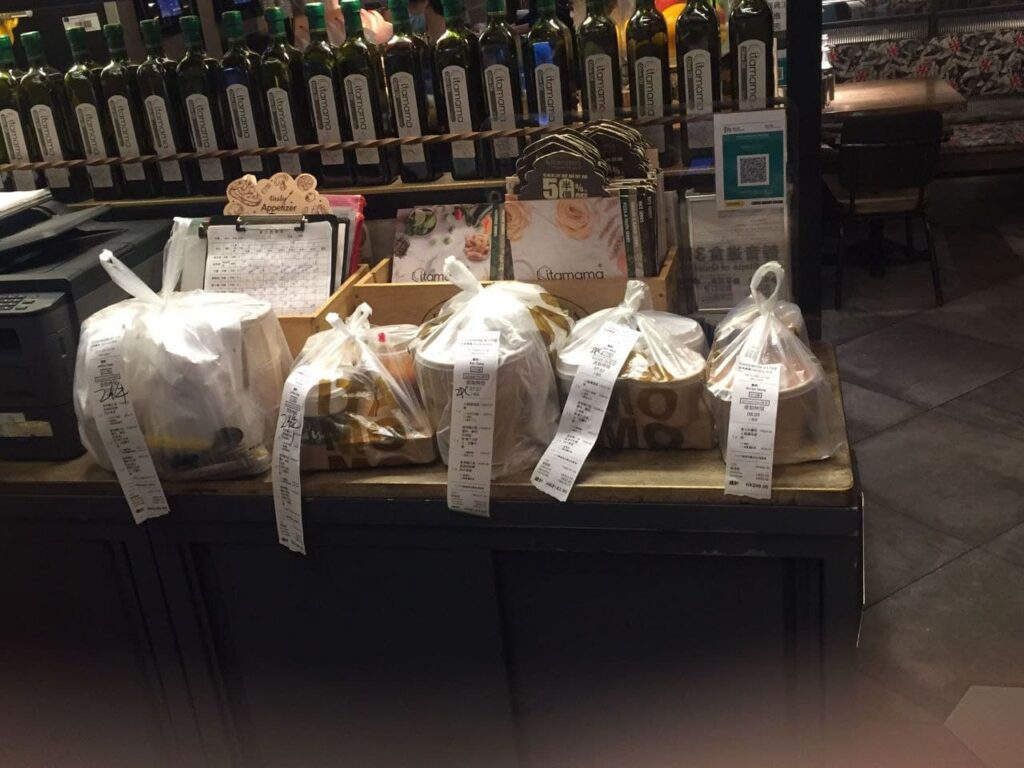
Workers had no trade union and were organising amongst themselves and with the help of the Riders’ Rights Concern Group, initiated by local labour organisations just before the walkouts took off.
“Once we knew there were strikes in different regions, we went to the sites to meet the workers,” says GaaWing, an activist with Concern, explaining how they helped to spread the strike.
After just two days of unofficial strikes, foodpanda agreed to have talks. Workers, alongside the Concern group and the former members of the Catering and Hotel Industries Employees General Union, a sub-organisation of the now-disbanded Confederation of the Trade Unions (HKCTU), then the largest trade union body in Hong Kong, met with foodpanda.
Just two days of unofficial strike action in a sector notoriously difficult to organise had brought the delivery giant to the table.
And as a result of the large-scale disruption, the strike attracted huge media attention, with around 30 to 40 reporters waiting outside the negotiations.
The two rounds of talks resulted in the company agreeing to almost all of the workers’ demands. Strikers cheered a phenomenal victory.
The demands that were won included:
The use of a road map instead of and aerial map to calculate delivery distance;
Stopping forced breaks, end of shifts, or suspension of accounts when couriers redispatch and decline orders with reasonable reasons;
Stopping the suspending riders’ accounts without good reasons, and re-activating those accounts that were previously suspended;
Improving the order assignment system that takes restaurant’s preparation time into account in order to reduce couriers’ waiting time.
One of these outcomes however – the introduction of a new system to calculate the distance workers travelled and measure their pay – backfired. Workers soon discovered that their pay was even lower than it had been before the strike, triggering a fresh round of strikes for fair pay and improved protections.
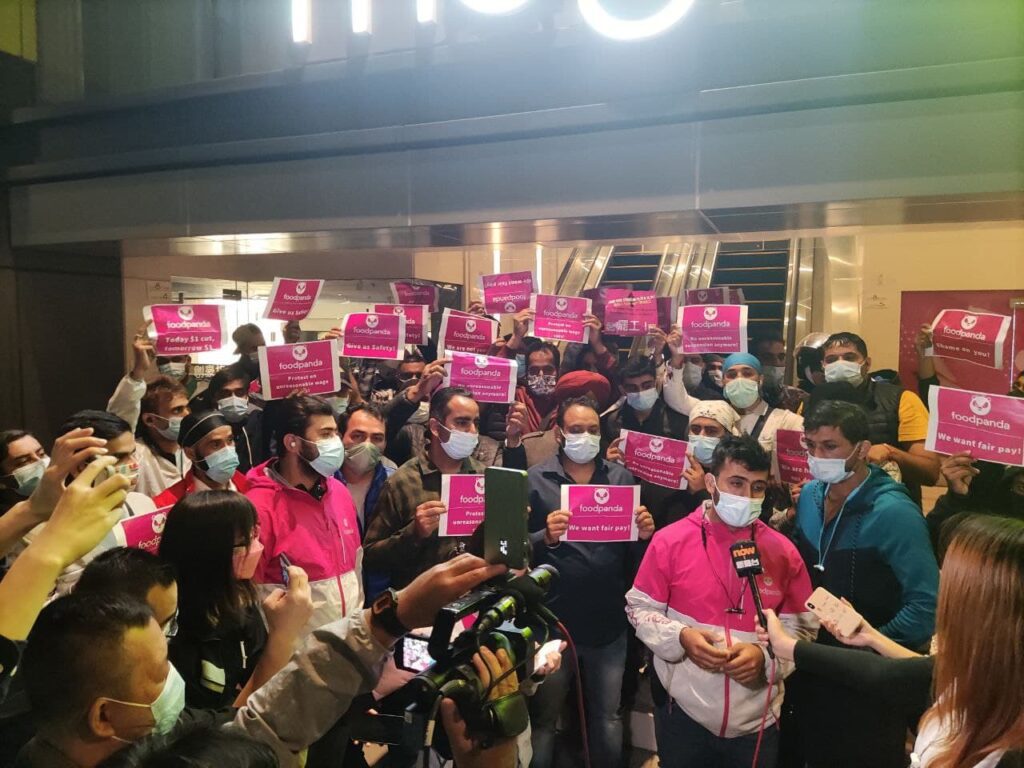
The 2022 Strike
With their contacts, SiuTong and GaaWing of the Concern group discussed with strike leaders from different regions about the tactics and demands of the next strike.
Strikes were more organised thanks to the networks that had been built in the first round of walkouts, but foodpanda was more prepared as well.
Two rounds of two-day strikes in October and November 2022 saw workers refuse to take orders as they had done previously, but the company didn’t back down.
One issue facing the strike was that part time delivery workers did not participate in the strike in the numbers required, partly because they were not as reliant on the job for their total income.
“The company had some new tactics,” GaaWing of Concern says.”When they knew when the strike days would be, they decided to increase pay for each delivery in order to undermine the striking workers.”
foodpanda also deployed tactics based on the profile of the delivery workers in Hong Kong, in an attempt to break the strike. Because of the density and urban structure of the city, some delivery orders are within walking distance. As a result, workers can be put into three categories: walker, cyclist, and motorcyclist.
While part time workers tend to be walkers, motorcyclists are likely to be full-time and more likely to participate in the strike.
And like in other places, ethnic minorities are overrepresented in the industry, with the majority of full-time workers being of South Asian heritage.
But the disconnect between groups of workers quickly became a barrier to organising.
“If you talk to a random walker and ask whether he knows other workers, most likely he will say no,” says SiuTong, another member of the Concern group. “So it’s harder to mobilise them to join the strike.”
This was quickly capitalised on by the company.
“For example, in Central, they suspended all the long distance and motorcyclist orders, as
Foodpanda thought it could still operate using just walkers and cyclists,” says GaaWing.
This meant that whilst the strike still hit the business, it did not result in as many uncollected orders.
After the first strike in October 2022, workers went on strike again in November.
Nonetheless, they were still not able to respond to the tactics that foodpanda deployed.
In the end, the strike was not as successful as the year before, and didn’t result in improving pay or enhancing workers rights.
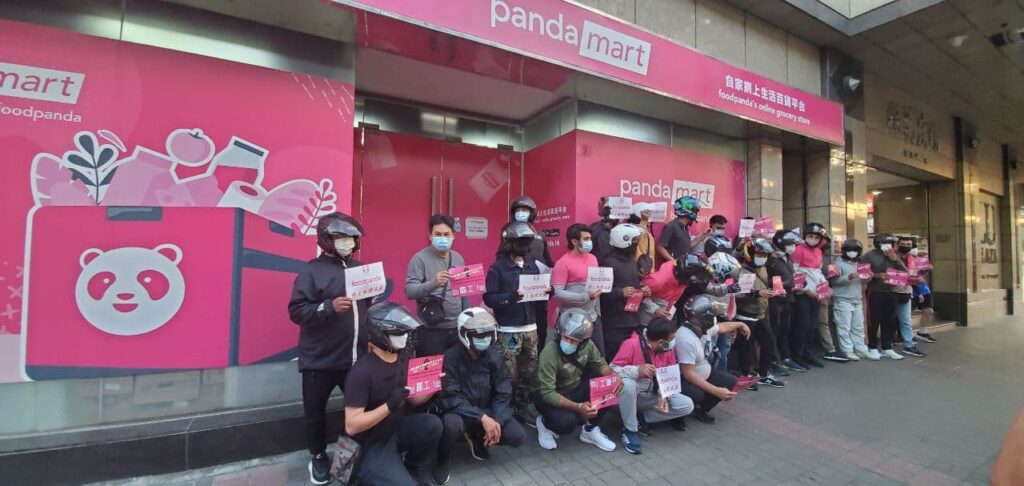
Long terms issues and the ambiguity of employer-worker relationship
If a basic right for workers is to know how much they will earn, and how their pay is calculated, then delivery workers in Hong Kong, as well as many other places, are being denied this right. There is little or no transparent information about their pay.
There are now two food delivery couriers, Foodpanda and Deliveroo, in Hong Kong, after the departure of Uber Eats in 2021.
Their payment calculation methods are not the same, but what is common is that the algorithm that calculates pay for every order is not known to workers.
On top of that, workers do not know how many orders they will receive and how heavy and how far the order will be. And if they reject the order, they risk a chance for a bonus and decrease to a lower rank, which in return affects how much they earn.
There are also “punishments” if workers refuse to take orders, for example a 15 minute time or a suspension of the account for a whole week, according to the Concern group.
For motorcyclists, their incomes are compensated by hidden costs including vehicles, fuel, and illegal parking tickets. There was a time when delivery companies covered the fines, but both companies have cancelled the policy which triggered a small-scale protest last year.
Delivery workers are among the most risky jobs in the city, as 28.8 per cent said they had been in an accident either during work or commuting to work, according to a study.
Delivery companies provide general insurance coverage but there is a lack of information among workers. Considering the complex procedure of claiming the insurance, workers may rely on government assistance instead, meaning that companies can offload the cost of caring for their workers.
“Defining delivery workers as employees in technical terms is not the most important thing,” says GaaWing. “What’s important is whether their rights are protected. For example basic rights like compensation for industrial injury, sick leave, stable wage. These are the bases that should be protected.”
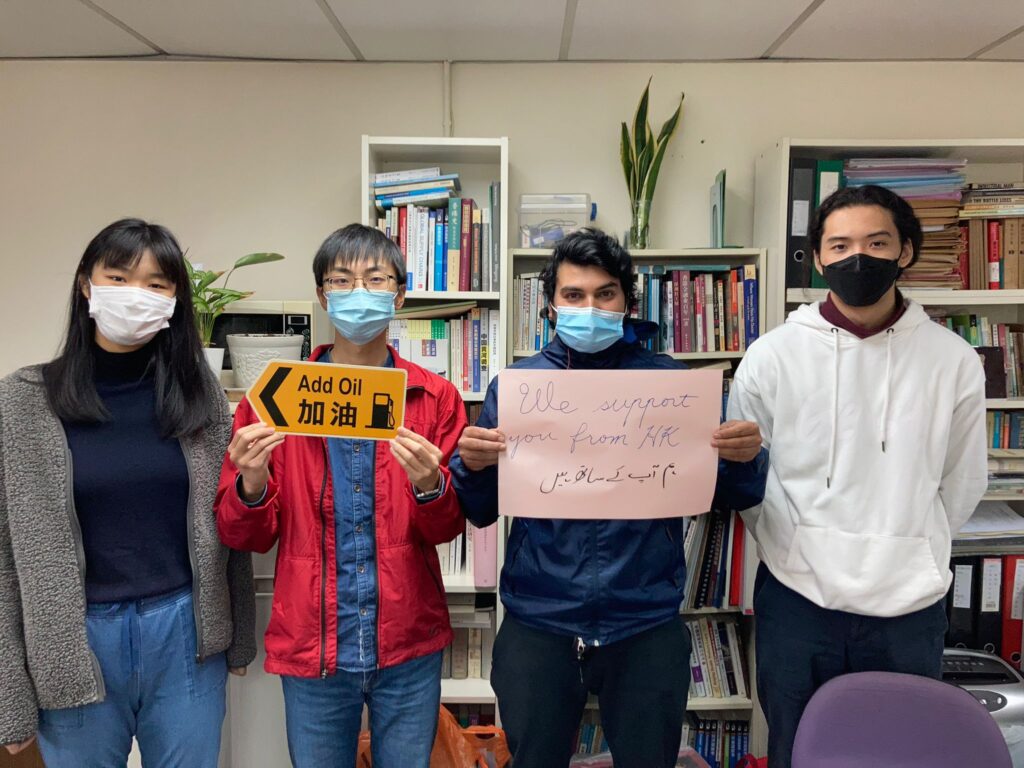
A gloomy future?
After the two large-scaled disputes, delivery workers have still seen their pay decrease. It may seem that the efforts of workers were in vain, but SiuTong thinks that industrial action is still crucial in their ongoing struggle.
“If workers did not go on strike in 2021, they would have their pay cut continued anyway,” he says. “If there wasn’t a strike, their pay nowadays might be even lower.”
And the 2021 strike did result in significant wins over terms and conditions.
“The strike in 2022 obviously did not force Foodpanda to make the changes we wanted, but they wouldn’t easily attack us again after seeing the strike. They know there will be consequences.”
There is a realisation that the Concern group, which isn’t a proper trade union, is maybe not the best way to organise workers.
Coming out of the strikes, the plan is to form a union which has an agenda for workers’ rights and is accountable to its members. This is no easy task, but has been made possible by the unofficial strikes.
The struggle by food delivery workers in Hong Kong continues.

